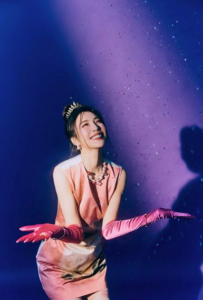
It’s been an interesting year for the members of Red Velvet, to say the least. Wendy has released her first mini-album, Irene and Seulgi debuted the group’s first sub-unit, and Irene became the centre of a scandal regarding her behaviour towards one of her stylists. Yeri has branched out to be the lead in an upcoming web drama. A whirlwind of ups and downs no doubt, and one thus far conspicuously free of the group’s fifth member, Joy.
With the fallout from Irene’s controversy reaching far, one could be forgiven for thinking this is behind SM’s decision to delay a full group comeback (2019’s “Psycho” was their latest). Without this focus on the whole group, we instead get windows of opportunity to see what the girls can do alone. After Wendy’s turn in April, now it’s Joy’s chance to shine, with her collection of 90s and 2000s covers, Hello.
When it comes to Joy, ‘shine’ is the operative word. Within Red Velvet, and in the larger idol world, she is famed for her charm and cheerful brightness, and her popularity is such that she has topped Girl Group Brand Power Ranking lists multiple times. She doesn’t have the name she has for nothing. When an idol group member releases a solo project, the key is always to identify and expand on that particular member’s persona, which is what Hello understands completely. The album is absolutely dripping with charm and sweetness, echoing the personality that has made Joy so compelling to the public.
As per the K-pop album standard, the opening track is the lead single and the strongest dilution of Joy’s talents, in the cover of the 1999 Park Hye-kyung song “Goodbye”, here altered to “Hello” in English. Joyous (pun intended) brass plays throughout the choruses, along with bright piano and fuzzy guitars in the backdrop, creating an instrumental that feels bouncy enough to jump up and join in with. Joy’s voice compliments this effortlessly, not belting but clear and steady. Her strength has always leant more towards tone and expression, and in this song she has it pitched perfectly: you can actually hear her smiling.
This charm radiates throughout the album, with Joy’s softness dancing through the melody of “Je T’aime”, her freedom bursting out the sing-a-long la-ing section of “Be There For You”, and her outright cuteness peeking into the closing lines of “Happy Birthday To You” (where she sings the actual birthday song). Even in the album’s slower moments of “Day By Day” and “If Only”, the mood of the music and her voice is always positive, always looking upward.
This is in no small part due to the choice to make the album a collection of covers from the turn of the century. The overall tone of Hello is one of sunny, mostly laid-back retro, which is unsurprising given that the original songs were all in the same style. Little has changed in “Je T’aime”s café chanson-lite tone from Hey‘s original, and the 90s version of “Goodbye” is pretty much just as jubilant and bright as Joy’s version, if ever-so-slightly less polished.

The production of the tracks shows no shame in turning this ‘retro chic’ dial all the way up to eleven here.
In “If Only” we get a flute solo in the bridge that is straight out of a 70s romance movie, and “Je T’aime” even begins with the scratching sounds of a needle on vinyl, before a jaunty 1960s piano joins in. The rhythms underlying each track mostly stay in the light, gentle, brushed with acoustic guitars and soft bass mode of easy-listening 2000s coffee shop music, and the overall effect aligns well with Joy’s personality as a singer. This style is even carried over into the album artwork, with one teaser image seemingly modelled directly after a 90s teen magazine, all high angles, bright colours and bubble graphics.
However, there is a question to be asked of these covers, suitable and charming as they are. Why is this specifically what was chosen for Joy for her first solo debut, outside of OSTs? This album follows on swiftly from Wendy’s mini-album, Like Water, released in April, and is just shy of a year after Irene and Seulgi’s debut with “Monster”, all work created for the members. Why original material hasn’t been provided for Joy is a curious one, and it begs the question of what might have been created for Joy if this strategy hadn’t been employed.

This question only becomes more glaring when considering Red Velvet’s discography. As a group known for playing artfully with styles within their music, and often creating some of the more experimental work of K-pop’s third generation, we know there is potential from SM production here.
This was a thought that often came to mind during the album’s weaker tracks, the often generic “Day By Day” and “If Only”. Hearing standard mid-tempo instrumental, with pleasant but unexciting vocals, led my mind to wonder off into comparisons to the dizzying falsettos of “Psycho”, or the spoken-chant verses of the wonderfully odd “Zimzalabim”. In choosing to record cover songs that seem the polar opposite of this playful pop, it seems as though Joy missed an opportunity to create these own unique moments for herself. The songs on this album are not of the same high-strange avant garde tinge of the best of Red Velvet’s work.
But that may partly be the key here: those songs are Red Velvet’s, not Joy’s. Though her persona and skills blend perfectly in her group, perhaps this album’s ultimate purpose is specifically to show the side of her that isn’t possible within the group’s sound. As mentioned above, that is the point of a solo album after all. Furthermore, when combining Joy’s happy persona and the easy, relaxed cheer of the album with the situation for most people in the world right now, the choice of these cover songs starts to make sense. As SM even stated themselves in describing the album’s title track, the aim is in “forgetting the hard days and meeting a new day”.

The key to K-pop’s current trend for retro stylings is in this desire to look back to simpler times, and this is exactly what Joy achieves. Whilst it is at the expense of her own creative stamp, these songs provide a direct connection to happier times. Through her wonderfully light and open vocal tone, and the near-perfect matching of song style to idol image, Joy’s debut album echoes her name happily. No, the tracks are not ground-breaking, and even risk underwhelming in comparison to her work with Red Velvet, but as its own collection, Hello is light, bright, and the ideal introduction to Joy’s charms.
(Images via: SM Entertainment.)


